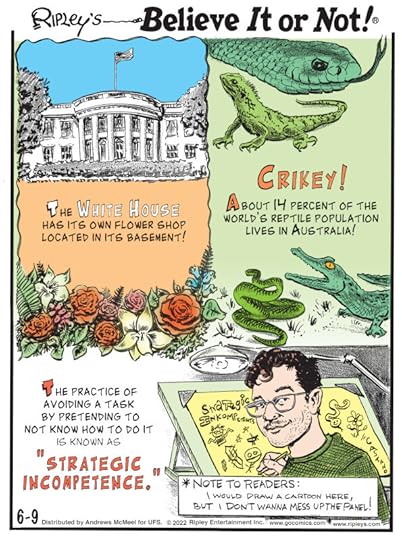Ripley Entertainment Inc.'s Blog, page 83
June 10, 2022
CARTOON 06-10-2022
June 9, 2022
Meet Pythagoras: Mathematician, Philosopher, and Bean Hater
Featured in Ripley's Believe It or Not!

We don’t know much about the life of Greek philosopher and mathematician Pythagoras, who was born around 570 BC. He is most famous for giving us the Pythagorean Theorem about the relation among the three sides of a right triangle — something you likely remember only vaguely from school but that has wide applications in building construction even today!
Who Was Pythagoras?Most of what we know about Pythagoras today actually comes from the writing of other philosophers, including Plato and Aristotle. Both of them credit Pythagoras with significant contributions to philosophical and religious thought. He was a firm believer in metempsychosis, the immortality and transmigration of souls.
That means, once you die, your immortal soul would migrate into a new body — possibly a human but also other kinds of animals.
According to philosopher Porphyry on his biography of Pythagoras, Pythagoras believed “that all things with souls should be regarded as akin.”
It was this belief that lead to Pythagoras’ practice of vegetarianism and to the rise of Pythagoreanism. Although it has been called a cult, Pythagoreanism followers mostly adhered to his basic beliefs in metempsychosis and vegetarianism. Though, to be fair, even this is hard to prove, as Pythagoras wrote no books himself and demanded absolute secrecy of his followers. The result? There are no written records of their practices and teachings.
But while vegetarianism wasn’t necessarily that rare in ancient times (biographer and philosopher Plutarch and Greek biologist and philosopher Theophrastus were both proponents of meat-free diets), Pythagoras’ absolute rejection of beans was certainly unique. More specifically, fava beans.
Not His Fava BeanThere are a few theories about Pythagoras’ avoidance of fava beans. A popular one is that he believed fava beans were potentially vessels for the souls of the dead (due to their flesh-like texture and their shape), so eating them would be a form of cannibalism. Additional theories say the aversion could have been due to something else — from the fact the beans resemble fetuses, human heads, or male and female genitalia (depending on who you ask) to the hollow stem of the plant being the gates of Hades.
Whatever the reason, beans were a definite no-no for Pythagoreanism followers.

Credit: Public Domain via Wikimedia Commons.
It’s Bean Fun While It LastedUnfortunately, Pythagoras’ aversion to fava beans might have been the reason for his death.
When the son of a wealthy nobleman was denied the chance to join Pythagoreanism (apparently, being rich did not give you the right to bypass the rigorous training and deep contemplation required to be allowed to join), he turned the townspeople against Pythagoras, leading to a massacre from which only a few were able to escape.
Pythagoras was one of the lucky ones, but only for a brief moment. As he was running from a burning building, he came upon a fava bean field. His only chance to escape was to trample through the field, stepping and crushing beans on his way to safety. Legend goes he couldn’t do it, and as he stood there frozen, his enemies caught up with him and stabbed him to death.
While the details on Pythagoras’ death might be a little sketchy, one thing is for sure: we won’t be looking at beans the same way from now on!
By Diana Bocco, contributor for Ripleys.com
EXPLORE THE ODD IN PERSON! Discover hundreds of strange and unusual artifacts and get hands-on with unbelievable interactives when you visit a Ripley’s Odditorium!Source: Meet Pythagoras: Mathematician, Philosopher, and Bean Hater
CARTOON 06-09-2022
June 8, 2022
Research Suggests Mushrooms Talk To Each Other
Featured in Ripley's Believe It or Not!

When we think of the brilliant flora and fauna of planet Earth, the usual suspects tend to come to mind, such as the great intelligence of dolphins, or elephants, and even, humbly speaking, ourselves.
Mushrooms, it’s probably fair to say, aren’t famed for their intelligence. For many, they’re controversial pizza toppings or dangerous poisonous horrors (not the same variety though, hopefully), and not much else. As it turns out, we’re not giving them nearly enough credit.
Astonishingly, the famed Koko the gorilla could use a vocabulary of more than 1,000 signs. Perhaps even more astonishingly, though, scientists believe that certain mushrooms may be able to communicate between themselves too, using a supposed vocabulary of 50 words!
Fun Guys To Chat WithMushrooms have always been fascinating case studies, thanks to their unique and potentially terrifying properties. The dreaded death cap mushroom, for instance, is so toxic that it causes sickness severe enough to cause irreparable damage to the cells in mere hours. Half of those poisoned by the death cap die, a fate that, in 1534, befell Pope Clement VII.
Mushrooms, clearly, are not to be underestimated. Particularly not now that we know they seem to be communicating with each other.
Fungi are often much more than what we see. In 1998, the largest known organism on the planet was discovered. At a reportedly four square miles large, how was it not discovered sooner? Because we didn’t know that what appeared to be multiple fungi were actually all a part of the same whole!

The Armillaria Ostoyae Credit: Henk Monster via Wikimedia Commons (CC BY-SA 3.0).
Believed to be up to 8,650 years old, the Armillaria ostoyae is found in the Blue Mountains of Oregon. Scientists tested samples in the region and found that they were related, part of one gigantic organism! Also known as the “Humongous Fungus,” the Armillaria ostoyae was connected through a string of hyphae that made up many small parts of the singular organism. It is through these small varied connections that the gigantic organism is able to thrive.
Now, you won’t hear tiny mushrooms talking away to each other at night in shady forests (that would truly be the stuff of nightmares), but through the magic of electric impulses, it seems they’re talking all the same!
Mysterious Mushroom MessagesUWE Bristol’s Andrew Adamatzky studied these impulses in several varieties of mushrooms. For the study, split gill, ghost, enoki, and caterpillar fungi were used. Data was collected via the use of electrodes, which were placed among the “roots” of this curious assortment of mushroom varieties. It was discovered that the pulses were not random but ordered. In a sophisticated fashion, in fact, to the degree that the coordination suggested the fungi were talking.
The pertinent question would be: What exactly do mushrooms talk about?
They often seem to be quite solitary organisms, revelling in the dark and the damp, but it seems that their primary concerns may be those shared by all forms of life: keeping themselves safe through warnings of danger and detecting something tasty and nutritious that may be within reach!
In April 2022, Adamatzky published the study titled “Language of fungi derived from their electrical spiking activity.” In research performed on the human brain, spikes in such activity and the region in which these spikes occur, can and have told us many things about how our own minds work.
Adamatzky, apparently being a rather fun guy, took the outlandish step to apply similar methodology when examining the communication of the mushrooms.
“We found that spikes are often clustered into trains,” the scientist writes, which would suggest not just a lot of activity, but a lot of coordinated activity. At these times, it seems, the fungi had something vital to tell each other. Spikes varied in frequency and intensity between the different species, and the study strove to determine the meaning of these events.
To do this, the researchers considered the length of words and vowels in English. The average lengths of a vowel sound in the English language, per the report, is 0.3 seconds, and this peculiar data made for fascinating reading. The length of a word in the “fungi” language, it seems, is incredibly similar to the length of a word in human languages. The average English word length is 4.8 spikes (the unit of measurement used in the study), and the spikes in a C. militaris train number 4.7!
In sum, these mushrooms aren’t just speaking, but they’re speaking in a manner similar to human speech!
Protection Against AttackersThese disparate, yet connected, colonies, would need to have some way of communicating for their own survival. The study suggests that this is what they’re doing: should a single mushroom’s state change, perhaps if it’s threatened, then these trains alert the rest of the whole, with electrical impulses running along as they do in our own nervous system.
It sounds remarkable, and it is, but it’s not without precedent.
It is understood that plants can communicate and coordinate. Herbal plants will form connections through “runners” that can connect them in the same plant system. Radboud University’s Josef Stuefer tested the communication skills of a clover by investigating the behavior of caterpillars. When a caterpillar ate a leaf from one of the connected plants, the critters that followed them were more unwilling to consume more of the compromised plant.
Why? Because the clover had sent a sort of defensive distress signal in response to the initial attack!
Stuefer reported that this action created a chemical reaction, making the rest of the leaves tougher and less appetizing. “This is an early warning system, very much like in military defense,” the researcher said, “each member of the network can receive the external signal of impending herbivore danger and transmit it to the other members of the network.”
It seems reasonable to assume this is part of the purpose of mushrooms’ communication: identifying dangers and reacting to them. As Adamatzky concluded, though, there is still much to be learned before we can truly decode the mushroom language, how sophisticated it really is, and the roots of its true purpose.
By Chris Littlechild, contributor for Ripleys.com
EXPLORE THE ODD IN PERSON! Discover hundreds of strange and unusual artifacts and get hands-on with unbelievable interactives when you visit a Ripley’s Odditorium!CARTOON 06-08-2022
June 7, 2022
Is The FBI Hiding Civil War–Era Buried Treasure?
Featured in Ripley's Believe It or Not!

Even school kids understand the adage “finders keepers.” But a group of Pennsylvania treasure hunters is claiming that the Federal Bureau of Investigation (FBI) may be ignoring this well-worn saying when it comes to a fabulous treasure hidden since the mid-19th century. Aptly titled Finders Keepers, the company is co-owned by Dennis and Kem Parada, and their recent dealings with the federal government regarding Civil War-era gold have led to legal action.
Here’s what you need to know about the lost gold that everyone wants to get their hands on, including the FBI.
The Myth Behind the Gold CacheFor generations, treasure hunters have scoured the thick forests of northwestern Pennsylvania in search of a fabled prize. A cache of gold that went missing around the time of the Battle of Gettysburg in 1863, per CBS News.
According to the myth, the Union Army transported a fabulous treasure of the glittering stuff from Wheeling, West Virginia, to the United States Mint in Philadelphia, Pennsylvania — but they never made it.
To avoid Confederate soldiers, the Union troops led by Lieutenant Castleton took a roundabout route through some of the wildest parts of Pennsylvania’s woods (via The Washington Post). While this strategy kept them off the radar of the Confederacy, it worked a little too well. The Union soldiers became hopelessly lost never to return, and the gold vanished with them.
Was it lost? Or perhaps stolen? Did the legendary gold even exist in the first place? These questions have haunted treasure hunters for decades.
The Scientific Analysis That Hit Pay DirtBut the hunt for the Civil War gold got a recent boost after a scientific analysis commissioned by the FBI uncovered an anomaly beneath the soil at Dent’s Run, located approximately 135 miles northeast of Pittsburgh. Performed by a geophysicist, the microgravity test revealed a subterranean mass consistent with the density of gold.
The mass came in at an estimated nine tons and filled the father-son duo behind Finders Keepers with the thrill of discovery, as reported by WWLP. The Paradas thought they’d finally solved one of America’s greatest treasure hunt mysteries. (Move over, Nicholas Cage!) If the underground anomaly did, indeed, prove to be a 19th-century treasure, it could be worth hundreds of millions of dollars. Finders Keepers led the FBI to the site in the hope that they’d receive a finder’s fee.
The FBI Steps inBut once the three-letter agency stepped in, things got weird. Agents claimed days of excavation yielded nothing more than an empty pit. Initially, this embarrassed the Paradas who started to second guess the scientific study and their own research and findings. Dennis Parada remembered that moment explaining, “They walk us in, and they make us look like dummies. Like we messed up.”
But then rumors started to surface that maybe the FBI found more than they let on. People living near Dent’s Run recounted late-night excavations and FBI-led convoys at odd hours. What’s more, the Paradas had time to reflect on what had transpired, and they felt more confident than ever that they’d been correct. As Kem Parada explains, “After my years of experience here using equipment, there was something here, something here of value, some kind of precious metal.”
The Legal Battle That’s BrewingIf the FBI did locate the gold, then they had many reasons to be secretive. After all, the discovery of a timeless Federal government treasure on state-owned land would touch off a legal battle. While some might wonder what all the fuss is about, millions are on the line. According to the original myth, the Union soldiers carried approximately 26 gold bars worth an estimated value of between $25 and $50 million.
But the FBI scan revealed a far larger deposit of some type of precious metal that could be worth upwards of $250 million! One’s thing is for sure, the Paradas refuse to give up when it comes to getting to the bottom of America’s lost treasure. And can you blame them?
By Engrid Barnett, contributor for Ripleys.com
EXPLORE THE ODD IN PERSON! Discover hundreds of strange and unusual artifacts and get hands-on with unbelievable interactives when you visit a Ripley’s Odditorium!CARTOON 06-07-2022
June 6, 2022
CARTOON 06-06-2022
June 5, 2022
CARTOON 06-05-2022
June 4, 2022
CARTOON 06-04-2022
Ripley Entertainment Inc.'s Blog
- Ripley Entertainment Inc.'s profile
- 52 followers










